Donate
0
Transkei
Scarp Forest
Located along the Wild Coast of South Africa, this dense, jungle-like forest biome is the most biodiverse in the country and is home to numerous important species of fauna and flora.
About
Transkei Scarp is a sanctuary of untamed biodiversity along South Africa's Wild Coast, located in the region previously known as the Transkei. These prehistoric forests trace back millions of years, with their massive trees and tangled undergrowth standing as living relics of a time when dinosaurs roamed, preserving an untold history of evolution and resilience. Typically found on coastal platforms or in deep gorges, these endangered forests are prime habitat for the elusive leopard. Bushpigs and blue duiker are common in the area, often foraging for food in the dense undergrowth.
Transkei Scarp
Forest Statistics
Rates of decreasing forest cover in South Africa’s Transkei scarp forests have accelerated over time, removing valuable above and below-ground carbon stores. Research in the Wild Coast’s Matiwane forests, between the Mbhashe and Umzimvubu rivers, quantified the loss of carbon stocks in the forests over 65 years up to 2007. The study found that 190 000 t of carbon stock had been lost from the conversion of forest areas into agricultural fields, while the harvesting of firewood and building timber released 300 t of carbon. The greatest contribution to total carbon stocks was soil carbon. In intact forests this contributed 54% of total carbon stored, compared to 78% in degraded forests and 68% in regrowth forests.
90%
of forest coverage/area lost
311.7
tC/ha total carbon stock: intact forest
73.5
tC/ha total carbon stock: degraded forest
190000t
carbon stock lost from forest clearing

Preserving a unique heritage
South Africa’s scarp forests are sometimes described as being a “transitional” forest type with characteristics that fall between the Afrotemperate and subtropical coastal forests. In different areas of the Eastern Cape, the scarp forests come into contact with the Amathole mistbelt forests, and in others they meet the region’s coastal dune forests. The scarp forests are not, however, made up solely of different elements of these other two forest types. Rather, they display their own separate and unique ecological characteristics and combinations of species. These forests have been picked out as a valuable biodiversity asset to South Africa and compared to other forest types are rich in endemic woody plant genera and species.
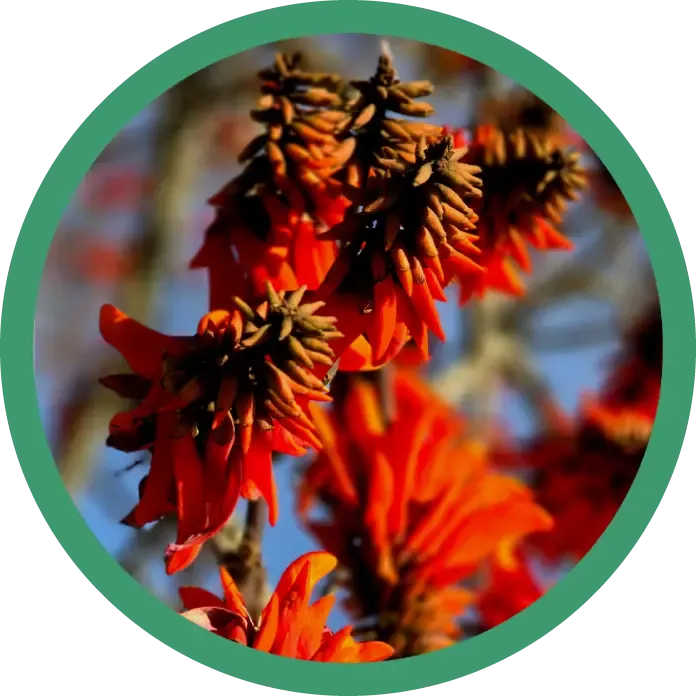
Traditional protection lost
The history of protection of forests within the scarp belt by traditional authorities dates back as far as the 1870s, when the last independent Xhosa King, Sarhili, protected the Dwesa and Manubi forests as nature reserves, forbidding hunting, tree felling, and cutting timber until his defeat in 1878. This marked the start of widespread destructive practices in the scarp forests, with an influx of wood cutters between 1878 and 1883. However, forests previously protected under the authority of headmen and chiefs are now coming under increasing pressure from uncontrolled use. This stems from inadequate management, insufficient resources to manage large areas, and lack of knowledge about the indigenous forests amongst many foresters.
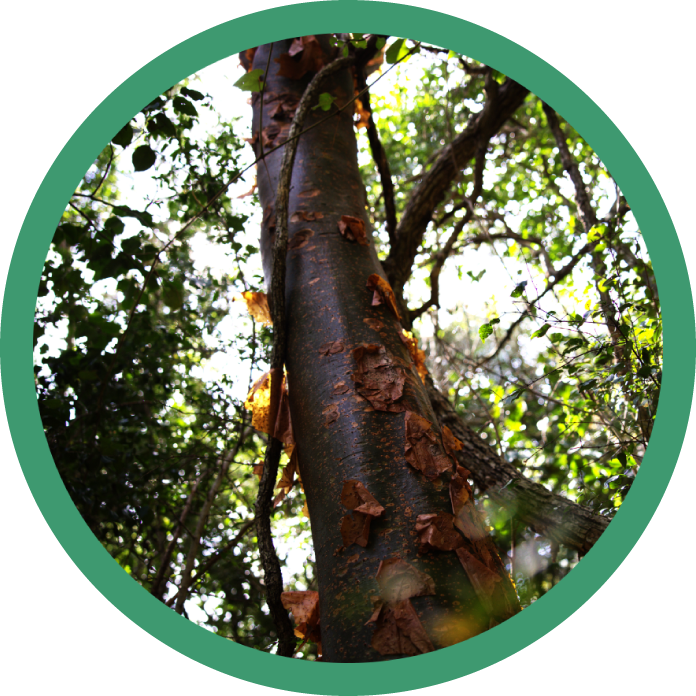
A history of forest exploitation
Between 1890 and 1904, Common yellowwoods represented 50% of all timber extracted from Manubi forest. Real yellowwoods accounted for 21%, while Ironwood comprised about 6% and Sneezewood just under 3.5%. Other tree species including White pear, White milkwood, and Cape teak (and likely Cape chestnut, Assegai, Essenhout, and Cape mahogany) made up the remainder, at just under 20%. Over these 14 years, an annual average of 17 722 cubic feet of timber was extracted from the forest, which up until just over a decade before had fallen under the protection of the Xhosa King, Sarhili. Despite forest protection and the development of sustainable forest management systems since 1939, there remains a need to restore degraded forest areas.

Magical Muthi and Ecosystem Services
Within Transkei’s forests, there are at least 25 tree species of which the bark is purported to have medicinal qualities and healing power. Ironwood bark, for example, is used to treat stomach and gallbladder problems. Transkei scarp forests also provide important ecosystem services to communities. These include the use of non-timber forest products such as the stems of the bamboo climber Flagellaria guineensis. This creeper is of major cultural and economic importance: its stems are used for basket-making and other woven products, and its economic value has been covered in scientific studies. The consumption of bushmeat is another ecosystem service, with the most commonly eaten species being bushbuck, bushpig, vervet monkey, and common duiker.

Preserving a unique heritage
South Africa’s scarp forests are sometimes described as being a “transitional” forest type with characteristics that fall between the Afrotemperate and subtropical coastal forests. In different areas of the Eastern Cape, the scarp forests come into contact with the Amathole mistbelt forests, and in others they meet the region’s coastal dune forests. The scarp forests are not, however, made up solely of different elements of these other two forest types. Rather, they display their own separate and unique ecological characteristics and combinations of species. These forests have been picked out as a valuable biodiversity asset to South Africa and compared to other forest types are rich in endemic woody plant genera and species.

Traditional protection lost
The history of protection of forests within the scarp belt by traditional authorities dates back as far as the 1870s, when the last independent Xhosa King, Sarhili, protected the Dwesa and Manubi forests as nature reserves, forbidding hunting, tree felling, and cutting timber until his defeat in 1878. This marked the start of widespread destructive practices in the scarp forests, with an influx of wood cutters between 1878 and 1883. However, forests previously protected under the authority of headmen and chiefs are now coming under increasing pressure from uncontrolled use. This stems from inadequate management, insufficient resources to manage large areas, and lack of knowledge about the indigenous forests amongst many foresters.

A history of forest exploitation
Between 1890 and 1904, Common yellowwoods represented 50% of all timber extracted from Manubi forest. Real yellowwoods accounted for 21%, while Ironwood comprised about 6% and Sneezewood just under 3.5%. Other tree species including White pear, White milkwood, and Cape teak (and likely Cape chestnut, Assegai, Essenhout, and Cape mahogany) made up the remainder, at just under 20%. Over these 14 years, an annual average of 17 722 cubic feet of timber was extracted from the forest, which up until just over a decade before had fallen under the protection of the Xhosa King, Sarhili. Despite forest protection and the development of sustainable forest management systems since 1939, there remains a need to restore degraded forest areas.

Magical Muthi and Ecosystem Services
Within Transkei’s forests, there are at least 25 tree species of which the bark is purported to have medicinal qualities and healing power. Ironwood bark, for example, is used to treat stomach and gallbladder problems. Transkei scarp forests also provide important ecosystem services to communities. These include the use of non-timber forest products such as the stems of the bamboo climber Flagellaria guineensis. This creeper is of major cultural and economic importance: its stems are used for basket-making and other woven products, and its economic value has been covered in scientific studies. The consumption of bushmeat is another ecosystem service, with the most commonly eaten species being bushbuck, bushpig, vervet monkey, and common duiker.

Preserving a unique heritage
South Africa’s scarp forests are sometimes described as being a “transitional” forest type with characteristics that fall between the Afrotemperate and subtropical coastal forests. In different areas of the Eastern Cape, the scarp forests come into contact with the Amathole mistbelt forests, and in others they meet the region’s coastal dune forests. The scarp forests are not, however, made up solely of different elements of these other two forest types. Rather, they display their own separate and unique ecological characteristics and combinations of species. These forests have been picked out as a valuable biodiversity asset to South Africa and compared to other forest types are rich in endemic woody plant genera and species.
Where we plant
Situated within the Maputaland–Pondoland–Albany biodiversity hotspot, the Transkei scarp forests are divided into 3 052 patches covering a total area of 61 484 ha. About 10.4% of these forests are protected. Most patches are found at low altitudes between 50 and 600 m. Most of the forests grow at the coast or in deep gorges, and they are often associated with krantzes (vertical walls of rock crowning mountain summits), scarps (very steep slopes), and coastal platforms. Transkei coastal scarp forests are the second most fragmented forest type in South Africa, making them highly vulnerable to impacts associated with edge effects. Wood collection and alien vegetation are significant threats to some of these forests.
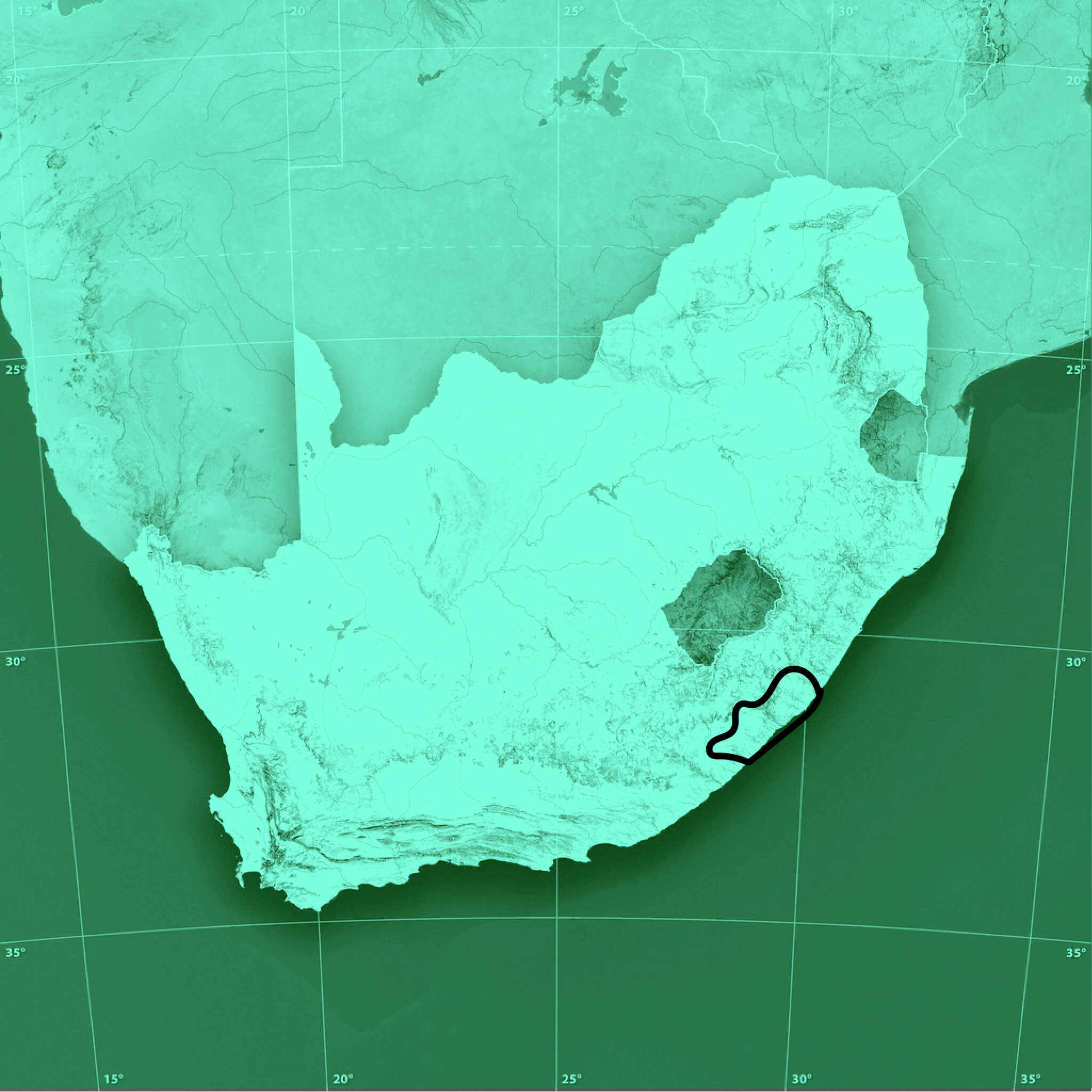
Plant for Tomorrow
Amathole
Mistbelt Forest
Located on the southern side of the Great Escarpment, these ancient African forests are renowned for their towering trees, crystal waterfalls, and overall captivating beauty.
About
The Amathole Mistbelt Forests are a remarkable biome located within and around the Amathole Mountains of the Eastern Cape, South Africa. This forest type is known for its diverse range of tree species, including tall evergreen, deciduous, and semi-deciduous trees with a canopy height of up to 30 metres (100 feet).
Our restoration efforts focus on the largest complex of Amathole Escarpment Forest, covering approximately 35,000 hectares (86,487 acres) and spanning an elevation range of 850 metres (2,789 feet) to 1,600 metres (5,249 feet) between Stutterheim and Hogsback. The forest is characterised by prominent canopy trees such as the Outeniqua Yellowwood (Afrocarpus falcatus), Red Current (Searsia chirindensis), and White Ironwood (Vepris lanceolata).
Amathole
Forest Statistics
South Africa's mistbelt forests play a vital role in carbon sequestration, though specific figures vary depending on forest size, species composition, and management practices. On average, these forests can sequester between 100 to 200 t/ha AGC, with mature, undisturbed forests often sequestering more. Nearly half the Amathole mistbelt forests are state-managed, but <1.5% are under strict protection. They are home to endemic species like the Giant golden mole and the Cape parrot, of which less than 2 000 wild individuals remain. While all indigenous forests combined cover 0.56% of South Africa’s total land area, mistbelt forests contain 5.36% of its plant species.
390
vegetation species
50
threatened plant species
80%
of forest coverage/area lost
8%
of mistbelt forest protected
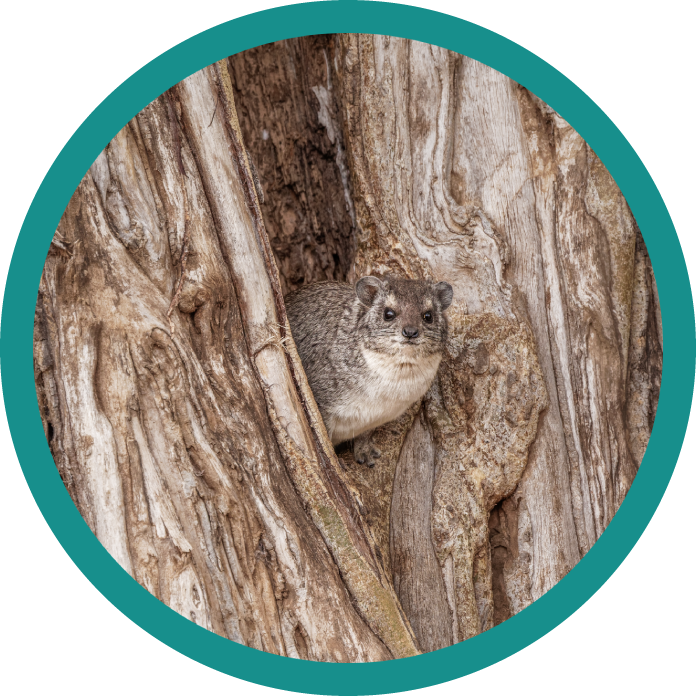
Conserving dassie dens
Nestled in the Amathole mistbelt forest between Qonce and Stutterheim, Pirie Forest has been rated as one of South Africa’s priority forests for conservation. At 3,170 ha, Pirie Forest is South Africa’s second-largest natural forest, after the Knysna Forest. It is also home to the locally endangered tree hyrax (Dendrohyrax arboreus), which uses a number of large tree species as dens. While Pirie Forest has relatively low levels of harvesting, several large cavity-bearing tree species in the forest – including the Outeniqua yellowwood and White pear (Apodytes dimidiata) – are important resources for local communities. Ongoing monitoring and conservation is needed to protect this rare nocturnal mammal, which has a restricted distribution range in South Africa.
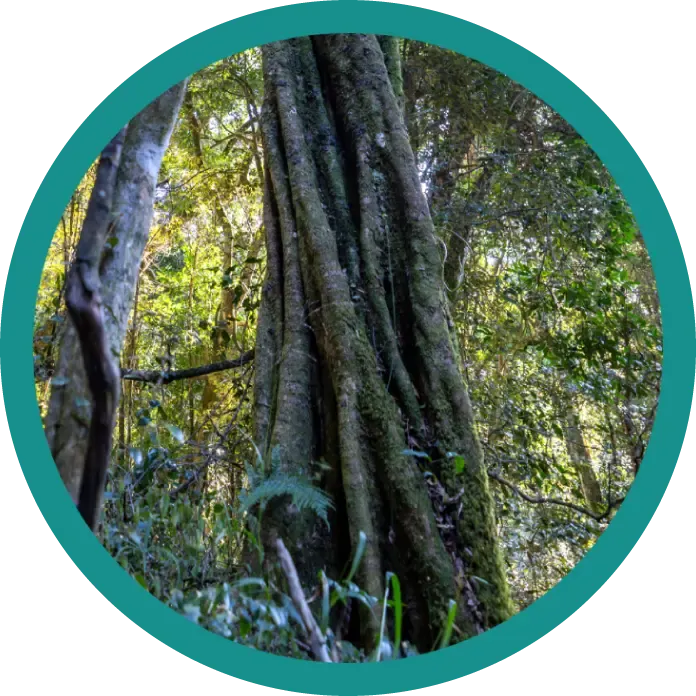
Conservation must consider regeneration
The southern mistbelt forest is one of the Afromontane forest biomes and the most extensive forest vegetation type in the Eastern Cape. While these forests have been found in the region for millions of years, they are now distributed in scattered and fragmented patches. Research shows that within these fragmented landscapes, the way trees recruit and regenerate is critical for forest persistence. To conserve Afromontane tree diversity it will be crucial to consider whether trees typically regenerate within their own canopy shadow or over a larger spatial scale. Trees that regenerate over a wider range are more effective in more fragmented forests, while those with a limited regeneration range come under more pressure as forest size decreases.
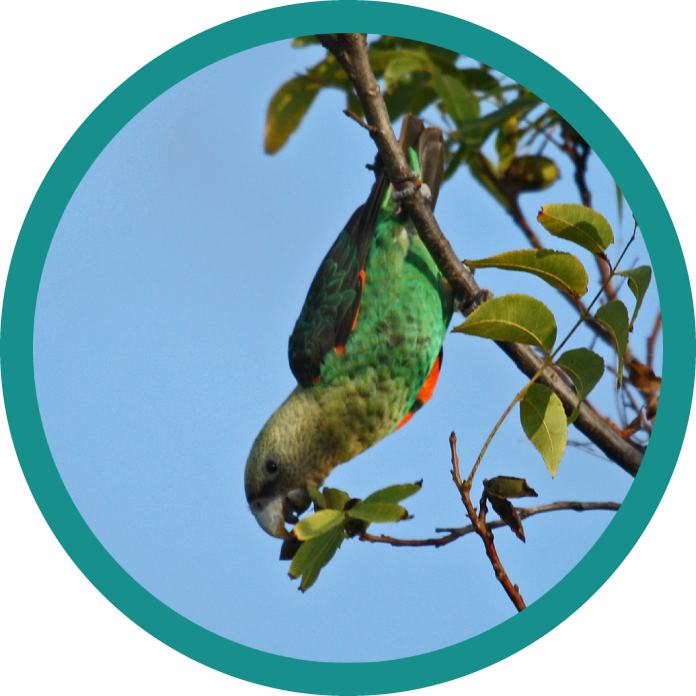
A parrot’s paradise
The Cape Parrot and Mistbelt Forest Action Plan was published in March 2020, following workshops involving 23 organisations, departments, and institutions. It presents a 10-year roadmap for Cape parrot conservation, which aims to double the area of Southern Mistbelt forest in the Eastern Cape under formal protection by 2030, and to protect at least 10% of habitat currently used by SA’s only endemic parrot species. A further stated target of the roadmap was to halt habitat degradation by 2025, especially in mature forest areas. Reforestation of the Amathole mistbelt forest biome can make a significant contribution to preserving this flagship species and maintain critical niche habitat areas for the Cape parrot at >100,000 ha.
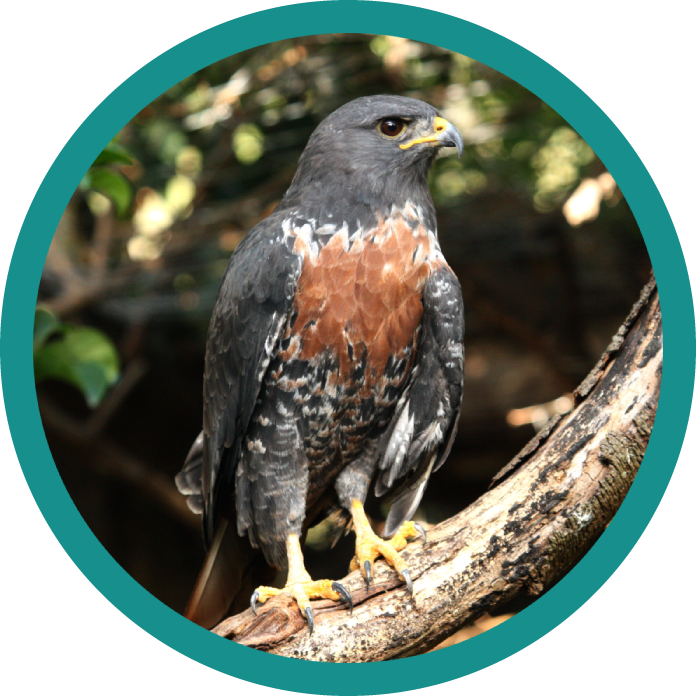
Bearing birds in mind
A reduction in forest size and complexity within SA’s southern mistbelt forests has a negative impact on the species richness and functional diversity of their bird populations. Birds are considered excellent indicators of ecological function, so when bird populations come under threat it serves as a warning sign for the entire ecosystem. Forest patches more isolated from other sections of forest have lower bird species diversity, while the structural complexity of the forests can be affected by the use of certain plant and tree species by human populations. The study recommends better regulatory standards governing the sustainable use of forest resources, in order to “promote a healthy and diverse habitat structure and safeguard avian communities”.

Conserving dassie dens
Nestled in the Amathole mistbelt forest between Qonce and Stutterheim, Pirie Forest has been rated as one of South Africa’s priority forests for conservation. At 3,170 ha, Pirie Forest is South Africa’s second-largest natural forest, after the Knysna Forest. It is also home to the locally endangered tree hyrax (Dendrohyrax arboreus), which uses a number of large tree species as dens. While Pirie Forest has relatively low levels of harvesting, several large cavity-bearing tree species in the forest – including the Outeniqua yellowwood and White pear (Apodytes dimidiata) – are important resources for local communities. Ongoing monitoring and conservation is needed to protect this rare nocturnal mammal, which has a restricted distribution range in South Africa.

Conservation must consider regeneration
The southern mistbelt forest is one of the Afromontane forest biomes and the most extensive forest vegetation type in the Eastern Cape. While these forests have been found in the region for millions of years, they are now distributed in scattered and fragmented patches. Research shows that within these fragmented landscapes, the way trees recruit and regenerate is critical for forest persistence. To conserve Afromontane tree diversity it will be crucial to consider whether trees typically regenerate within their own canopy shadow or over a larger spatial scale. Trees that regenerate over a wider range are more effective in more fragmented forests, while those with a limited regeneration range come under more pressure as forest size decreases.

A parrot’s paradise
The Cape Parrot and Mistbelt Forest Action Plan was published in March 2020, following workshops involving 23 organisations, departments, and institutions. It presents a 10-year roadmap for Cape parrot conservation, which aims to double the area of Southern Mistbelt forest in the Eastern Cape under formal protection by 2030, and to protect at least 10% of habitat currently used by SA’s only endemic parrot species. A further stated target of the roadmap was to halt habitat degradation by 2025, especially in mature forest areas. Reforestation of the Amathole mistbelt forest biome can make a significant contribution to preserving this flagship species and maintain critical niche habitat areas for the Cape parrot at >100,000 ha.

Bearing birds in mind
A reduction in forest size and complexity within SA’s southern mistbelt forests has a negative impact on the species richness and functional diversity of their bird populations. Birds are considered excellent indicators of ecological function, so when bird populations come under threat it serves as a warning sign for the entire ecosystem. Forest patches more isolated from other sections of forest have lower bird species diversity, while the structural complexity of the forests can be affected by the use of certain plant and tree species by human populations. The study recommends better regulatory standards governing the sustainable use of forest resources, in order to “promote a healthy and diverse habitat structure and safeguard avian communities”.

Conserving dassie dens
Nestled in the Amathole mistbelt forest between Qonce and Stutterheim, Pirie Forest has been rated as one of South Africa’s priority forests for conservation. At 3,170 ha, Pirie Forest is South Africa’s second-largest natural forest, after the Knysna Forest. It is also home to the locally endangered tree hyrax (Dendrohyrax arboreus), which uses a number of large tree species as dens. While Pirie Forest has relatively low levels of harvesting, several large cavity-bearing tree species in the forest – including the Outeniqua yellowwood and White pear (Apodytes dimidiata) – are important resources for local communities. Ongoing monitoring and conservation is needed to protect this rare nocturnal mammal, which has a restricted distribution range in South Africa.
Where we plant
The Amathole mistbelt forests are some of the southernmost Afromontane forests, comprising the southern portion of KZN and the Eastern Cape’s southern mistbelt forest vegetation unit. These forests grow on south and southeast facing slopes of the Amathole mountains in the Eastern Cape midlands, mostly at altitudes between 1 200 and 1400 m. Situated within the Maputaland–Pondoland–Albany biodiversity hotspot, the Amathole mistbelt forests form one of South Africa’s most biodiverse high-altitude forest biomes. Tree species diversity is relatively uniform across South Africa’s scattered patches of southern mistbelt forest, but diversity is higher in larger forest patches located closer to each other. The herbaceous layer plays a significant role in forest patch composition and structure.
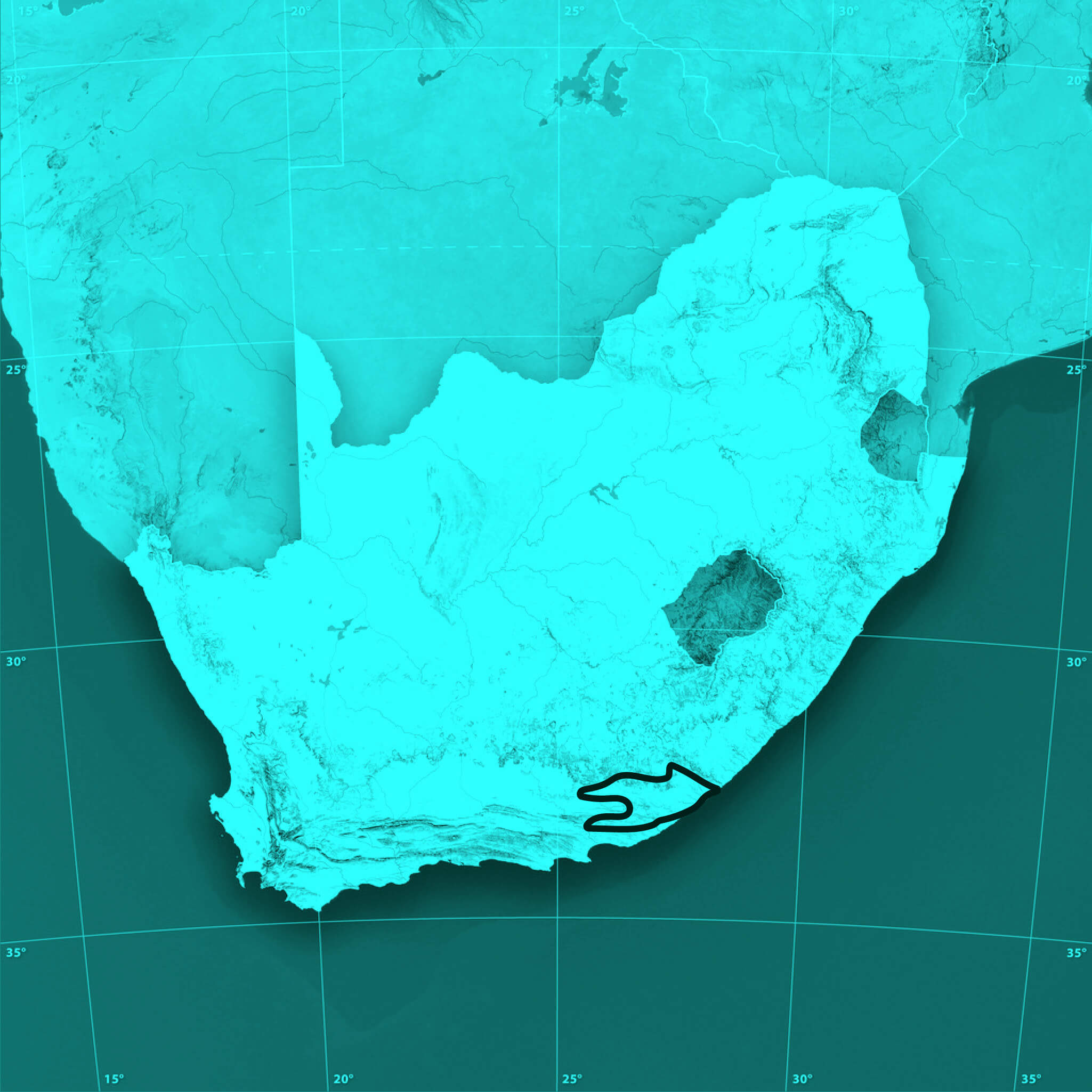
Plant for Tomorrow
Transkei
Scarp Forest
Located along the Wild Coast of South Africa, this dense, jungle-like forest biome is the most biodiverse in the country and is home to numerous important species of fauna and flora.
About
Transkei Scarp is a sanctuary of untamed biodiversity along South Africa's Wild Coast, located in the region previously known as the Transkei. These prehistoric forests trace back millions of years, with their massive trees and tangled undergrowth standing as living relics of a time when dinosaurs roamed, preserving an untold history of evolution and resilience. Typically found on coastal platforms or in deep gorges, these endangered forests are prime habitat for the elusive leopard. Bushpigs and blue duiker are common in the area, often foraging for food in the dense undergrowth.
Transkei Scarp
Forest Statistics
Rates of decreasing forest cover in South Africa’s Transkei scarp forests have accelerated over time, removing valuable above and below-ground carbon stores. Research in the Wild Coast’s Matiwane forests, between the Mbhashe and Umzimvubu rivers, quantified the loss of carbon stocks in the forests over 65 years up to 2007. The study found that 190 000 t of carbon stock had been lost from the conversion of forest areas into agricultural fields, while the harvesting of firewood and building timber released 300 t of carbon. The greatest contribution to total carbon stocks was soil carbon. In intact forests this contributed 54% of total carbon stored, compared to 78% in degraded forests and 68% in regrowth forests.
90%
of forest coverage/area lost
311.7
tC/ha total carbon stock: intact forest
73.5
tC/ha total carbon stock: degraded forest
190000t
carbon stock lost from forest clearing

Preserving a unique heritage
South Africa’s scarp forests are sometimes described as being a “transitional” forest type with characteristics that fall between the Afrotemperate and subtropical coastal forests. In different areas of the Eastern Cape, the scarp forests come into contact with the Amathole mistbelt forests, and in others they meet the region’s coastal dune forests. The scarp forests are not, however, made up solely of different elements of these other two forest types. Rather, they display their own separate and unique ecological characteristics and combinations of species. These forests have been picked out as a valuable biodiversity asset to South Africa and compared to other forest types are rich in endemic woody plant genera and species.

Traditional protection lost
The history of protection of forests within the scarp belt by traditional authorities dates back as far as the 1870s, when the last independent Xhosa King, Sarhili, protected the Dwesa and Manubi forests as nature reserves, forbidding hunting, tree felling, and cutting timber until his defeat in 1878. This marked the start of widespread destructive practices in the scarp forests, with an influx of wood cutters between 1878 and 1883. However, forests previously protected under the authority of headmen and chiefs are now coming under increasing pressure from uncontrolled use. This stems from inadequate management, insufficient resources to manage large areas, and lack of knowledge about the indigenous forests amongst many foresters.

A history of forest exploitation
Between 1890 and 1904, Common yellowwoods represented 50% of all timber extracted from Manubi forest. Real yellowwoods accounted for 21%, while Ironwood comprised about 6% and Sneezewood just under 3.5%. Other tree species including White pear, White milkwood, and Cape teak (and likely Cape chestnut, Assegai, Essenhout, and Cape mahogany) made up the remainder, at just under 20%. Over these 14 years, an annual average of 17 722 cubic feet of timber was extracted from the forest, which up until just over a decade before had fallen under the protection of the Xhosa King, Sarhili. Despite forest protection and the development of sustainable forest management systems since 1939, there remains a need to restore degraded forest areas.

Magical Muthi and Ecosystem Services
Within Transkei’s forests, there are at least 25 tree species of which the bark is purported to have medicinal qualities and healing power. Ironwood bark, for example, is used to treat stomach and gallbladder problems. Transkei scarp forests also provide important ecosystem services to communities. These include the use of non-timber forest products such as the stems of the bamboo climber Flagellaria guineensis. This creeper is of major cultural and economic importance: its stems are used for basket-making and other woven products, and its economic value has been covered in scientific studies. The consumption of bushmeat is another ecosystem service, with the most commonly eaten species being bushbuck, bushpig, vervet monkey, and common duiker.

Preserving a unique heritage
South Africa’s scarp forests are sometimes described as being a “transitional” forest type with characteristics that fall between the Afrotemperate and subtropical coastal forests. In different areas of the Eastern Cape, the scarp forests come into contact with the Amathole mistbelt forests, and in others they meet the region’s coastal dune forests. The scarp forests are not, however, made up solely of different elements of these other two forest types. Rather, they display their own separate and unique ecological characteristics and combinations of species. These forests have been picked out as a valuable biodiversity asset to South Africa and compared to other forest types are rich in endemic woody plant genera and species.

Traditional protection lost
The history of protection of forests within the scarp belt by traditional authorities dates back as far as the 1870s, when the last independent Xhosa King, Sarhili, protected the Dwesa and Manubi forests as nature reserves, forbidding hunting, tree felling, and cutting timber until his defeat in 1878. This marked the start of widespread destructive practices in the scarp forests, with an influx of wood cutters between 1878 and 1883. However, forests previously protected under the authority of headmen and chiefs are now coming under increasing pressure from uncontrolled use. This stems from inadequate management, insufficient resources to manage large areas, and lack of knowledge about the indigenous forests amongst many foresters.

A history of forest exploitation
Between 1890 and 1904, Common yellowwoods represented 50% of all timber extracted from Manubi forest. Real yellowwoods accounted for 21%, while Ironwood comprised about 6% and Sneezewood just under 3.5%. Other tree species including White pear, White milkwood, and Cape teak (and likely Cape chestnut, Assegai, Essenhout, and Cape mahogany) made up the remainder, at just under 20%. Over these 14 years, an annual average of 17 722 cubic feet of timber was extracted from the forest, which up until just over a decade before had fallen under the protection of the Xhosa King, Sarhili. Despite forest protection and the development of sustainable forest management systems since 1939, there remains a need to restore degraded forest areas.

Magical Muthi and Ecosystem Services
Within Transkei’s forests, there are at least 25 tree species of which the bark is purported to have medicinal qualities and healing power. Ironwood bark, for example, is used to treat stomach and gallbladder problems. Transkei scarp forests also provide important ecosystem services to communities. These include the use of non-timber forest products such as the stems of the bamboo climber Flagellaria guineensis. This creeper is of major cultural and economic importance: its stems are used for basket-making and other woven products, and its economic value has been covered in scientific studies. The consumption of bushmeat is another ecosystem service, with the most commonly eaten species being bushbuck, bushpig, vervet monkey, and common duiker.

Preserving a unique heritage
South Africa’s scarp forests are sometimes described as being a “transitional” forest type with characteristics that fall between the Afrotemperate and subtropical coastal forests. In different areas of the Eastern Cape, the scarp forests come into contact with the Amathole mistbelt forests, and in others they meet the region’s coastal dune forests. The scarp forests are not, however, made up solely of different elements of these other two forest types. Rather, they display their own separate and unique ecological characteristics and combinations of species. These forests have been picked out as a valuable biodiversity asset to South Africa and compared to other forest types are rich in endemic woody plant genera and species.
Where we plant
Situated within the Maputaland–Pondoland–Albany biodiversity hotspot, the Transkei scarp forests are divided into 3 052 patches covering a total area of 61 484 ha. About 10.4% of these forests are protected. Most patches are found at low altitudes between 50 and 600 m. Most of the forests grow at the coast or in deep gorges, and they are often associated with krantzes (vertical walls of rock crowning mountain summits), scarps (very steep slopes), and coastal platforms. Transkei coastal scarp forests are the second most fragmented forest type in South Africa, making them highly vulnerable to impacts associated with edge effects. Wood collection and alien vegetation are significant threats to some of these forests.

Plant for Tomorrow
Amathole
Mistbelt Forest
Located on the southern side of the Great Escarpment, these ancient African forests are renowned for their towering trees, crystal waterfalls, and overall captivating beauty.
About
The Amathole Mistbelt Forests are a remarkable biome located within and around the Amathole Mountains of the Eastern Cape, South Africa. This forest type is known for its diverse range of tree species, including tall evergreen, deciduous, and semi-deciduous trees with a canopy height of up to 30 metres (100 feet).
Our restoration efforts focus on the largest complex of Amathole Escarpment Forest, covering approximately 35,000 hectares (86,487 acres) and spanning an elevation range of 850 metres (2,789 feet) to 1,600 metres (5,249 feet) between Stutterheim and Hogsback. The forest is characterised by prominent canopy trees such as the Outeniqua Yellowwood (Afrocarpus falcatus), Red Current (Searsia chirindensis), and White Ironwood (Vepris lanceolata).
Amathole
Forest Statistics
South Africa's mistbelt forests play a vital role in carbon sequestration, though specific figures vary depending on forest size, species composition, and management practices. On average, these forests can sequester between 100 to 200 t/ha AGC, with mature, undisturbed forests often sequestering more. Nearly half the Amathole mistbelt forests are state-managed, but <1.5% are under strict protection. They are home to endemic species like the Giant golden mole and the Cape parrot, of which less than 2 000 wild individuals remain. While all indigenous forests combined cover 0.56% of South Africa’s total land area, mistbelt forests contain 5.36% of its plant species.
390
vegetation species
50
threatened plant species
80%
of forest coverage/area lost
8%
of mistbelt forest protected

Conserving dassie dens
Nestled in the Amathole mistbelt forest between Qonce and Stutterheim, Pirie Forest has been rated as one of South Africa’s priority forests for conservation. At 3,170 ha, Pirie Forest is South Africa’s second-largest natural forest, after the Knysna Forest. It is also home to the locally endangered tree hyrax (Dendrohyrax arboreus), which uses a number of large tree species as dens. While Pirie Forest has relatively low levels of harvesting, several large cavity-bearing tree species in the forest – including the Outeniqua yellowwood and White pear (Apodytes dimidiata) – are important resources for local communities. Ongoing monitoring and conservation is needed to protect this rare nocturnal mammal, which has a restricted distribution range in South Africa.

Conservation must consider regeneration
The southern mistbelt forest is one of the Afromontane forest biomes and the most extensive forest vegetation type in the Eastern Cape. While these forests have been found in the region for millions of years, they are now distributed in scattered and fragmented patches. Research shows that within these fragmented landscapes, the way trees recruit and regenerate is critical for forest persistence. To conserve Afromontane tree diversity it will be crucial to consider whether trees typically regenerate within their own canopy shadow or over a larger spatial scale. Trees that regenerate over a wider range are more effective in more fragmented forests, while those with a limited regeneration range come under more pressure as forest size decreases.

A parrot’s paradise
The Cape Parrot and Mistbelt Forest Action Plan was published in March 2020, following workshops involving 23 organisations, departments, and institutions. It presents a 10-year roadmap for Cape parrot conservation, which aims to double the area of Southern Mistbelt forest in the Eastern Cape under formal protection by 2030, and to protect at least 10% of habitat currently used by SA’s only endemic parrot species. A further stated target of the roadmap was to halt habitat degradation by 2025, especially in mature forest areas. Reforestation of the Amathole mistbelt forest biome can make a significant contribution to preserving this flagship species and maintain critical niche habitat areas for the Cape parrot at >100,000 ha.

Bearing birds in mind
A reduction in forest size and complexity within SA’s southern mistbelt forests has a negative impact on the species richness and functional diversity of their bird populations. Birds are considered excellent indicators of ecological function, so when bird populations come under threat it serves as a warning sign for the entire ecosystem. Forest patches more isolated from other sections of forest have lower bird species diversity, while the structural complexity of the forests can be affected by the use of certain plant and tree species by human populations. The study recommends better regulatory standards governing the sustainable use of forest resources, in order to “promote a healthy and diverse habitat structure and safeguard avian communities”.

Conserving dassie dens
Nestled in the Amathole mistbelt forest between Qonce and Stutterheim, Pirie Forest has been rated as one of South Africa’s priority forests for conservation. At 3,170 ha, Pirie Forest is South Africa’s second-largest natural forest, after the Knysna Forest. It is also home to the locally endangered tree hyrax (Dendrohyrax arboreus), which uses a number of large tree species as dens. While Pirie Forest has relatively low levels of harvesting, several large cavity-bearing tree species in the forest – including the Outeniqua yellowwood and White pear (Apodytes dimidiata) – are important resources for local communities. Ongoing monitoring and conservation is needed to protect this rare nocturnal mammal, which has a restricted distribution range in South Africa.

Conservation must consider regeneration
The southern mistbelt forest is one of the Afromontane forest biomes and the most extensive forest vegetation type in the Eastern Cape. While these forests have been found in the region for millions of years, they are now distributed in scattered and fragmented patches. Research shows that within these fragmented landscapes, the way trees recruit and regenerate is critical for forest persistence. To conserve Afromontane tree diversity it will be crucial to consider whether trees typically regenerate within their own canopy shadow or over a larger spatial scale. Trees that regenerate over a wider range are more effective in more fragmented forests, while those with a limited regeneration range come under more pressure as forest size decreases.

A parrot’s paradise
The Cape Parrot and Mistbelt Forest Action Plan was published in March 2020, following workshops involving 23 organisations, departments, and institutions. It presents a 10-year roadmap for Cape parrot conservation, which aims to double the area of Southern Mistbelt forest in the Eastern Cape under formal protection by 2030, and to protect at least 10% of habitat currently used by SA’s only endemic parrot species. A further stated target of the roadmap was to halt habitat degradation by 2025, especially in mature forest areas. Reforestation of the Amathole mistbelt forest biome can make a significant contribution to preserving this flagship species and maintain critical niche habitat areas for the Cape parrot at >100,000 ha.

Bearing birds in mind
A reduction in forest size and complexity within SA’s southern mistbelt forests has a negative impact on the species richness and functional diversity of their bird populations. Birds are considered excellent indicators of ecological function, so when bird populations come under threat it serves as a warning sign for the entire ecosystem. Forest patches more isolated from other sections of forest have lower bird species diversity, while the structural complexity of the forests can be affected by the use of certain plant and tree species by human populations. The study recommends better regulatory standards governing the sustainable use of forest resources, in order to “promote a healthy and diverse habitat structure and safeguard avian communities”.

Conserving dassie dens
Nestled in the Amathole mistbelt forest between Qonce and Stutterheim, Pirie Forest has been rated as one of South Africa’s priority forests for conservation. At 3,170 ha, Pirie Forest is South Africa’s second-largest natural forest, after the Knysna Forest. It is also home to the locally endangered tree hyrax (Dendrohyrax arboreus), which uses a number of large tree species as dens. While Pirie Forest has relatively low levels of harvesting, several large cavity-bearing tree species in the forest – including the Outeniqua yellowwood and White pear (Apodytes dimidiata) – are important resources for local communities. Ongoing monitoring and conservation is needed to protect this rare nocturnal mammal, which has a restricted distribution range in South Africa.
Where we plant
The Amathole mistbelt forests are some of the southernmost Afromontane forests, comprising the southern portion of KZN and the Eastern Cape’s southern mistbelt forest vegetation unit. These forests grow on south and southeast facing slopes of the Amathole mountains in the Eastern Cape midlands, mostly at altitudes between 1 200 and 1400 m. Situated within the Maputaland–Pondoland–Albany biodiversity hotspot, the Amathole mistbelt forests form one of South Africa’s most biodiverse high-altitude forest biomes. Tree species diversity is relatively uniform across South Africa’s scattered patches of southern mistbelt forest, but diversity is higher in larger forest patches located closer to each other. The herbaceous layer plays a significant role in forest patch composition and structure.

Plant for Tomorrow
Transkei
Scarp Forest
Located along the Wild Coast of South Africa, this dense, jungle-like forest biome is the most biodiverse in the country and is home to numerous important species of fauna and flora.
About
Transkei Scarp is a sanctuary of untamed biodiversity along South Africa's Wild Coast, located in the region previously known as the Transkei. These prehistoric forests trace back millions of years, with their massive trees and tangled undergrowth standing as living relics of a time when dinosaurs roamed, preserving an untold history of evolution and resilience. Typically found on coastal platforms or in deep gorges, these endangered forests are prime habitat for the elusive leopard. Bushpigs and blue duiker are common in the area, often foraging for food in the dense undergrowth.
Transkei Scarp
Forest Statistics
Rates of decreasing forest cover in South Africa’s Transkei scarp forests have accelerated over time, removing valuable above and below-ground carbon stores. Research in the Wild Coast’s Matiwane forests, between the Mbhashe and Umzimvubu rivers, quantified the loss of carbon stocks in the forests over 65 years up to 2007. The study found that 190 000 t of carbon stock had been lost from the conversion of forest areas into agricultural fields, while the harvesting of firewood and building timber released 300 t of carbon. The greatest contribution to total carbon stocks was soil carbon. In intact forests this contributed 54% of total carbon stored, compared to 78% in degraded forests and 68% in regrowth forests.
90%
of forest coverage/area lost
311.7
tC/ha total carbon stock: intact forest
73.5
tC/ha total carbon stock: degraded forest
190000t
carbon stock lost from forest clearing

Preserving a unique heritage
South Africa’s scarp forests are sometimes described as being a “transitional” forest type with characteristics that fall between the Afrotemperate and subtropical coastal forests. In different areas of the Eastern Cape, the scarp forests come into contact with the Amathole mistbelt forests, and in others they meet the region’s coastal dune forests. The scarp forests are not, however, made up solely of different elements of these other two forest types. Rather, they display their own separate and unique ecological characteristics and combinations of species. These forests have been picked out as a valuable biodiversity asset to South Africa and compared to other forest types are rich in endemic woody plant genera and species.

Traditional protection lost
The history of protection of forests within the scarp belt by traditional authorities dates back as far as the 1870s, when the last independent Xhosa King, Sarhili, protected the Dwesa and Manubi forests as nature reserves, forbidding hunting, tree felling, and cutting timber until his defeat in 1878. This marked the start of widespread destructive practices in the scarp forests, with an influx of wood cutters between 1878 and 1883. However, forests previously protected under the authority of headmen and chiefs are now coming under increasing pressure from uncontrolled use. This stems from inadequate management, insufficient resources to manage large areas, and lack of knowledge about the indigenous forests amongst many foresters.

A history of forest exploitation
Between 1890 and 1904, Common yellowwoods represented 50% of all timber extracted from Manubi forest. Real yellowwoods accounted for 21%, while Ironwood comprised about 6% and Sneezewood just under 3.5%. Other tree species including White pear, White milkwood, and Cape teak (and likely Cape chestnut, Assegai, Essenhout, and Cape mahogany) made up the remainder, at just under 20%. Over these 14 years, an annual average of 17 722 cubic feet of timber was extracted from the forest, which up until just over a decade before had fallen under the protection of the Xhosa King, Sarhili. Despite forest protection and the development of sustainable forest management systems since 1939, there remains a need to restore degraded forest areas.

Magical Muthi and Ecosystem Services
Within Transkei’s forests, there are at least 25 tree species of which the bark is purported to have medicinal qualities and healing power. Ironwood bark, for example, is used to treat stomach and gallbladder problems. Transkei scarp forests also provide important ecosystem services to communities. These include the use of non-timber forest products such as the stems of the bamboo climber Flagellaria guineensis. This creeper is of major cultural and economic importance: its stems are used for basket-making and other woven products, and its economic value has been covered in scientific studies. The consumption of bushmeat is another ecosystem service, with the most commonly eaten species being bushbuck, bushpig, vervet monkey, and common duiker.

Preserving a unique heritage
South Africa’s scarp forests are sometimes described as being a “transitional” forest type with characteristics that fall between the Afrotemperate and subtropical coastal forests. In different areas of the Eastern Cape, the scarp forests come into contact with the Amathole mistbelt forests, and in others they meet the region’s coastal dune forests. The scarp forests are not, however, made up solely of different elements of these other two forest types. Rather, they display their own separate and unique ecological characteristics and combinations of species. These forests have been picked out as a valuable biodiversity asset to South Africa and compared to other forest types are rich in endemic woody plant genera and species.

Traditional protection lost
The history of protection of forests within the scarp belt by traditional authorities dates back as far as the 1870s, when the last independent Xhosa King, Sarhili, protected the Dwesa and Manubi forests as nature reserves, forbidding hunting, tree felling, and cutting timber until his defeat in 1878. This marked the start of widespread destructive practices in the scarp forests, with an influx of wood cutters between 1878 and 1883. However, forests previously protected under the authority of headmen and chiefs are now coming under increasing pressure from uncontrolled use. This stems from inadequate management, insufficient resources to manage large areas, and lack of knowledge about the indigenous forests amongst many foresters.

A history of forest exploitation
Between 1890 and 1904, Common yellowwoods represented 50% of all timber extracted from Manubi forest. Real yellowwoods accounted for 21%, while Ironwood comprised about 6% and Sneezewood just under 3.5%. Other tree species including White pear, White milkwood, and Cape teak (and likely Cape chestnut, Assegai, Essenhout, and Cape mahogany) made up the remainder, at just under 20%. Over these 14 years, an annual average of 17 722 cubic feet of timber was extracted from the forest, which up until just over a decade before had fallen under the protection of the Xhosa King, Sarhili. Despite forest protection and the development of sustainable forest management systems since 1939, there remains a need to restore degraded forest areas.

Magical Muthi and Ecosystem Services
Within Transkei’s forests, there are at least 25 tree species of which the bark is purported to have medicinal qualities and healing power. Ironwood bark, for example, is used to treat stomach and gallbladder problems. Transkei scarp forests also provide important ecosystem services to communities. These include the use of non-timber forest products such as the stems of the bamboo climber Flagellaria guineensis. This creeper is of major cultural and economic importance: its stems are used for basket-making and other woven products, and its economic value has been covered in scientific studies. The consumption of bushmeat is another ecosystem service, with the most commonly eaten species being bushbuck, bushpig, vervet monkey, and common duiker.

Preserving a unique heritage
South Africa’s scarp forests are sometimes described as being a “transitional” forest type with characteristics that fall between the Afrotemperate and subtropical coastal forests. In different areas of the Eastern Cape, the scarp forests come into contact with the Amathole mistbelt forests, and in others they meet the region’s coastal dune forests. The scarp forests are not, however, made up solely of different elements of these other two forest types. Rather, they display their own separate and unique ecological characteristics and combinations of species. These forests have been picked out as a valuable biodiversity asset to South Africa and compared to other forest types are rich in endemic woody plant genera and species.
Where we plant
Situated within the Maputaland–Pondoland–Albany biodiversity hotspot, the Transkei scarp forests are divided into 3 052 patches covering a total area of 61 484 ha. About 10.4% of these forests are protected. Most patches are found at low altitudes between 50 and 600 m. Most of the forests grow at the coast or in deep gorges, and they are often associated with krantzes (vertical walls of rock crowning mountain summits), scarps (very steep slopes), and coastal platforms. Transkei coastal scarp forests are the second most fragmented forest type in South Africa, making them highly vulnerable to impacts associated with edge effects. Wood collection and alien vegetation are significant threats to some of these forests.

Plant for Tomorrow
Transkei Scarp
Transkei Scarp